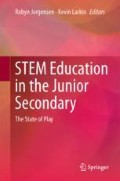Abstract
A major response to the growing concern with diminishing engagement and participation of students in STEM pathways, in Australia and internationally, has been the involvement of the STEM community in school outreach activities. In Australia there has been a proliferation of links between scientists and schools, with the aim of engaging students in authentic activities and providing models of what STEM work pathways might entail. This chapter will draw on a series of projects studying partnerships between the professional science/mathematics communities and schools, to explore a range of partnership models, the experience and outcomes for students and teachers, and challenges for crossing the boundary between school and STEM professional communities. Such school/STEM community partnerships are particularly suited to studies related to environmental and sustainability issues, a focus explored in the chapter. Further, we will draw on a recent evaluation of the Australia-wide, CSIRO-led Scientists and Mathematicians in Schools (SMiS) program. That study provided insight into the use and outcomes of the SMiS model. We will explore some of the challenges of working across the school-STEM professional practice boundary, implications for curriculum, and differences in partnerships for mathematics compared to science.
Access this chapter
Tax calculation will be finalised at checkout
Purchases are for personal use only
References
ACARA (v 7.5). Links to the Australian curriculum. Retrieved from links at each reference.
Akkerman, S. F., & Bakker, A. (2011). Boundary crossing and boundary objects. Review of Educational Research, 81(2), 132–169.
Birkett, T. (n.d.). The Truax. Retrieved from woodfloors.org/truax.pdf
Burgin, S. R., Sadler, T. D., & Koroly, M. J. (2012). High school student participation in scientific research apprenticeships: Variation in and relationships among student experiences and outcomes. Research in Science Education, 42, 439–467.
Cripps Clark, J., Tytler, R., & Symington, D. (2014). School-community collaborations: Bringing authentic science into schools. Teaching Science, 60(3), 28–34.
Cunningham, S., Theilacker, M., Gahan, P., Callan, V., & Rainnie, A. (2016). Skills and capabilities for Australian enterprise innovation. Melbourne, Vic: Australian Council of Learned Academies. www.acola.org.au
Education Council of Australia. (2015). National STEM school education strategy. http://www.educationcouncil.edu.au/site/DefaultSite/filesystem/documents/National%20STEM%20School%20Education%20Strategy.pdf
Forbes, G. A. (2014). MyScience: Communities of practice around the teaching and learning of primary science. Unpublished doctoral thesis. Southern Cross University, Lismore, NSW. http://epubs.scu.edu.au/theses/366/
Galbraith, P., Stillman, G., & Brown, J. (2010). Turning ideas into modeling problems. In R. Lesh, P. Galbraith, C. Haines, & A. Hurford (Eds.), Modeling students’ mathematical modeling competencies: ICTMA 13 (pp. 243–283). New York: Springer.
Gibbs, C. (2013). Dune Dudes – A school program. Southwest Catchments Council. Retrieved from http://swccnrm.org.au/wp-content/themes/blanktheme/inc/casestudy/CST-%20Dune%20Dudes%20-%20C.%20Gibbs.pdf
GLOBE Education. (n.d.). The Global Learning and Observations to Benefit the Environment (GLOBE) Program. Retrieved from http://www.globe.gov/about/overview
Howitt, C., & Rennie, L. J. (2008). Evaluation of the scientists in schools Pilot project. ACT: CSIRO. Available online at http://www.scientistsinschools.edu.au/evaluation.htm
Husher, K. (2010). Evaluation framework for Australian science and maths outreach programs in schools. PhD, University of Newcastle, Newcastle, Australia.
Marginson, S., Tytler, R., Freeman, B., & Roberts, K. (2013). STEM: Country comparisons. Melbourne: The Australian Council of Learned Academies. www.acola.org.au
Masters, G. (2013). Australian education review. Reforming educational assessment: Imperatives, principles, and challenges. Melbourne, Vic: Australian Council for Educational Research.
Ministerial Council on Education, Employment, Training and Youth Affairs. (2008). Melbourne declaration on educational goals for young Australians. Retrieved June 26, 2016, at: http://www.curriculum.edu.au/verve/_resources/National_Declaration_on_the_Educational_Goals_for_Young_Australians.pdf
National Curriculum Board. (2009). Shape of the Australian Curriculum: Mathematics. Barton, ACT: Commonwealth of Australia.
New Zealand Office of the Prime Minister’s Science Advisory Committee. (2011). Looking ahead: Science education for the twenty first century. Wellington, NZ: New Zealand Office of the Prime Minister’s Science Advisory Committee.
Office of the Chief Scientist. (2016). STEM Programme Index 2016. Retrieved from http://www.chiefscientist.gov.au/2016/01/spi-2016-stem-programme-index-2016-2/
Rennie, L. J. (2012). “A very valuable partnership”. Evaluation of the Scientists in Schools Project, 2011–2012. Dickson, ACT: CSIRO Education. Retrieved from http://www.scientsitsinschools.edu.au/evaluation.htm
Rennie, L. J., & Howitt, C. (2009). “Science has changed my life!” Evaluation of the scientists in schools project. Dickson, ACT: CSIRO.
Shimizu, Y., & Williams, G. (2013). Studying learners in intercultural contexts. In K. Clements, A. Bishop, J. Kilpatrick, F. Leung, & C. Keitel (Eds.), Third international handbook in mathematics education (pp. 145–168). New York: Springer.
Symington, D., & Tytler, R. (2011). Schools and teachers supporting student open investigations. Teaching Science, 57(1), 8–12.
Tytler, R., & Symington, D. (2015). Science learning in rural Australia: Not necessarily the poor cousin. Teaching Science, 61(3), 19–25.
Tytler, R., Symington, D., & Cripps Clark, J. (2016). Community-school collaborations in science: Towards improved outcomes through better understanding of boundary issues. International Journal of Science and Mathematics Education, 15, 643–661. doi:10.1007/s10763-015-9711-9.
Tytler, R., Symington, D., Kirkwood, V., & Malcolm, C. (2008). Engaging students in authentic science through school – Community links: Learning from the rural experience. Teaching Science, 54(3), 13–18.
Tytler, R., Symington, D., & Smith, C. (2011). A curriculum innovation framework for science, technology and mathematics education. Research in Science Education, 41, 19–38.
Tytler, R., Symington, D., Williams, G., White, P., Campbell, C., Chittleborough, G., Upstill, G., Roper, E., & Dziadkiewicz, N. (2015). Building productive partnerships for STEM Education: Evaluating the model and outcomes of the Scientists and Mathematicians in Schools program. Melbourne, Vic: Deakin University. Available at: http://www.scientistsinschools.edu.au/downloads/SMiSEvaluationReport2015.pdf
Williams, G., & Huang, H. M. (2015). Learning and cognition in mathematics. In S. J. Cho (Ed.), The proceedings of the 12th international congress on mathematics education (pp. 497–502).
Author information
Authors and Affiliations
Corresponding author
Editor information
Editors and Affiliations
Rights and permissions
Copyright information
© 2018 Springer Nature Singapore Pte Ltd.
About this chapter
Cite this chapter
Tytler, R., Symington, D., Williams, G., White, P. (2018). Enlivening STEM Education Through School-Community Partnerships. In: Jorgensen, R., Larkin, K. (eds) STEM Education in the Junior Secondary. Springer, Singapore. https://doi.org/10.1007/978-981-10-5448-8_12
Download citation
DOI: https://doi.org/10.1007/978-981-10-5448-8_12
Published:
Publisher Name: Springer, Singapore
Print ISBN: 978-981-10-5447-1
Online ISBN: 978-981-10-5448-8
eBook Packages: EducationEducation (R0)

